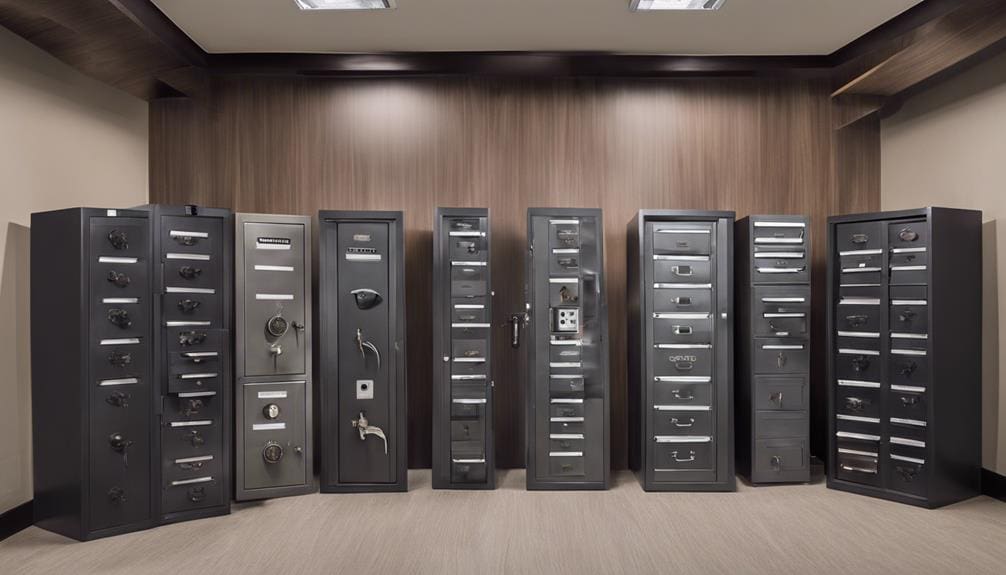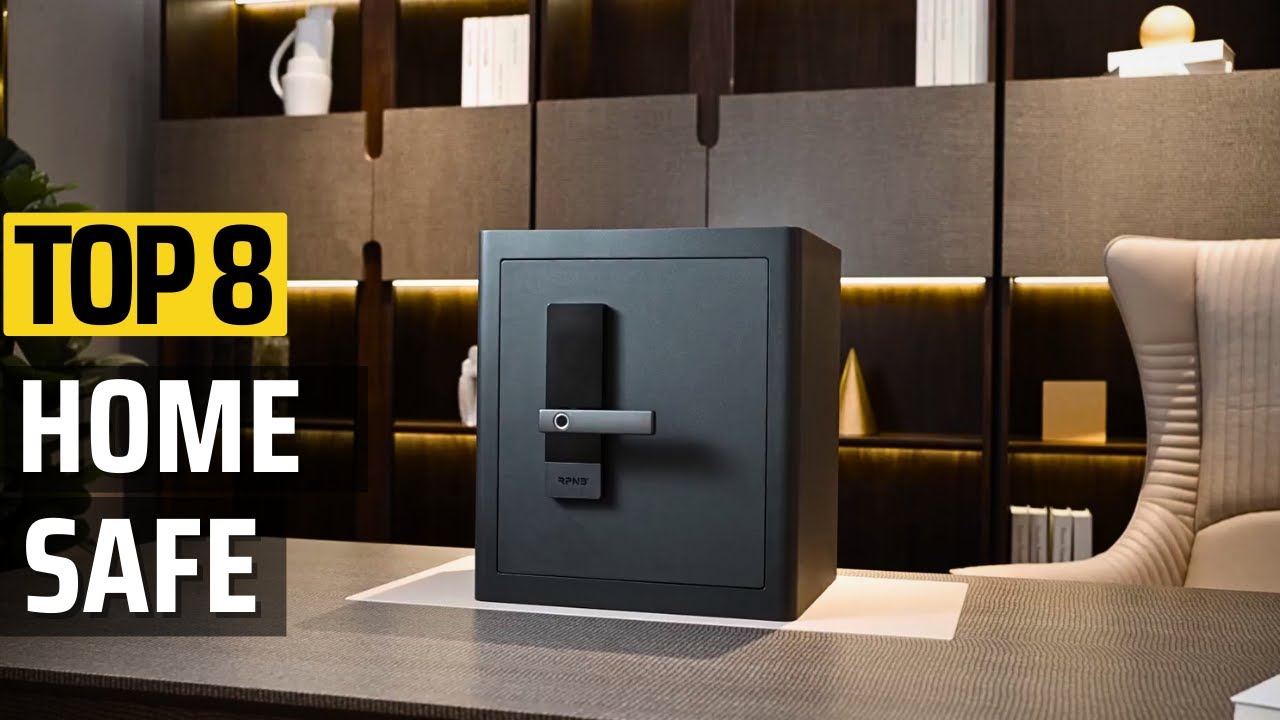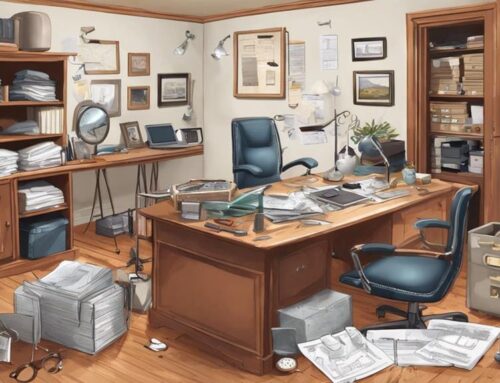To protect your valuables effectively, choose the right type of security safe. Wall safes offer hidden security and are installed between studs. Floor safes anchor into concrete for robust protection. Jewelry safes feature soft interiors and advanced locks. Gun safes focus on solid construction and reliable locking mechanisms. Fire-resistant safes provide varying levels of fire protection, check for UL certification. Data safes maintain low temperatures to safeguard electronic media. Depository safes streamline business cash management with secure slots. Hotel safes offer compact, secure storage for travelers. Each type provides unique benefits tailored to different needs, ensuring best protection. Learn the specifics now.
Key Takeaways
- Wall safes offer hidden security and can be concealed behind decor for added protection.
- Floor safes provide strong security and can be anchored into concrete floors to prevent unauthorized movement.
- Jewelry safes feature soft linings, organized compartments, and advanced locking mechanisms to protect delicate items.
- Gun safes use heavy gauge steel and solid plate doors with various locking systems to secure firearms effectively.
- Fire-resistant safes with UL certifications and reinforced materials ensure valuables withstand high temperatures and fire damage.
Wall Safes
Wall safes are a discreet and secure way to protect your valuables by installing them directly into your home’s walls. They offer a hidden form of security, making it difficult for thieves to locate and access your valuables. To install a wall safe, choose a location between the studs of your wall. This guarantees the safe is securely mounted and concealed.
Start by using a stud finder to locate the studs and mark the desired height of the safe. Cut out the drywall to match the safe’s dimensions. Next, place the safe into the cavity, ensuring it fits snugly. Secure it by screwing it into the studs on either side, providing a solid anchor. Once installed, the safe can be further hidden behind decor like paintings or mirrors, enhancing its concealment.
Wall safes are ideal for storing cash, jewelry, and important documents, offering both security and peace of mind. By keeping these items out of sight, you’re effectively preventing theft. Their discreet design and secure installation make wall safes a popular choice for enhancing home security. Remember, the key to their effectiveness is proper installation and clever concealment.
Floor Safes
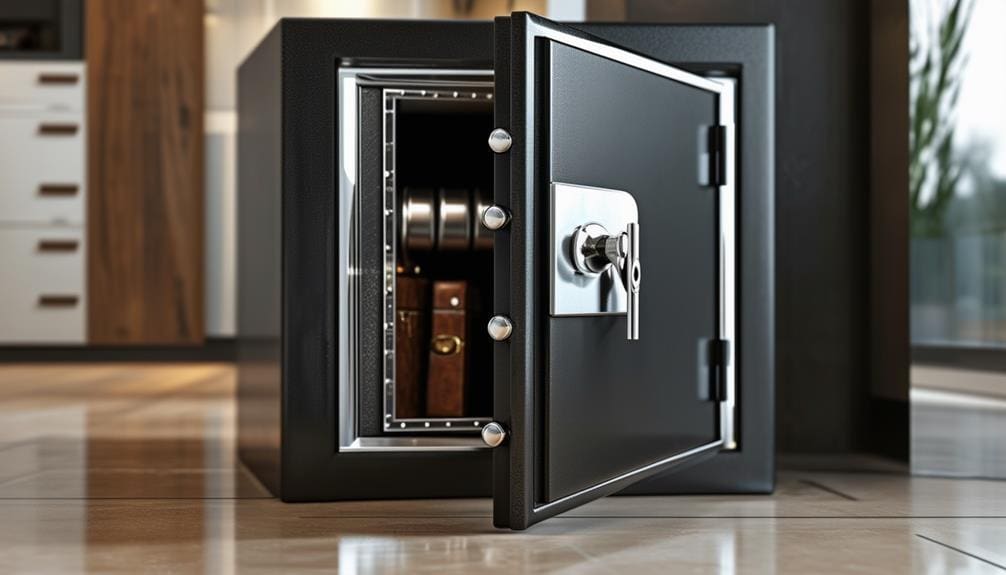
Floor safes provide a strong security solution by being installed directly into the ground, often hidden beneath furniture or carpets. This makes them ideal for concealing your valuables from potential thieves. When considering a floor safe, think about what you need to store. They come in various sizes to meet different storage needs, whether it’s money, important documents, or other valuables.
The installation process is critical for maximizing security. First, choose an inconspicuous location, like under a piece of heavy furniture or a carpet. Assess the thickness of your floor; concrete floors are best for anchoring. To install, you’ll need to cut a hole in the floor that matches the dimensions of your safe. Ensure the safe fits securely into this cavity.
Anchoring the safe into concrete is essential. Use heavy-duty bolts to secure it, preventing unauthorized movement. This makes it nearly impossible for thieves to remove the safe without specialized tools and considerable effort. Finally, cover the safe with furniture or a rug to enhance concealment.
Jewelry Safes
When selecting a jewelry safe, you’ll want to think about the interior lining options to safeguard your delicate pieces from scratches. Examine the security features like biometric locks and reinforced steel construction to guarantee maximum protection. Organized drawers and shelves will help you keep your collection accessible and secure.
Interior Lining Options
To safeguard your valuable gems and metals, jewelry safes often showcase soft interior linings such as velvet or felt. These linings are crafted to prevent scratches and damage to your delicate jewelry. A safe interior lining guarantees that your valuable pieces remain in pristine condition, free from tarnishing, and untangled.
Jewelry safes also come with organized drawers and shelves to keep your items separated and easily accessible. This feature allows you to maintain order and quickly locate specific pieces when needed. Additionally, many jewelry safes offer customizable interior configurations to accommodate various types and sizes of jewelry, ensuring that your unique collection is perfectly stored.
Interior lighting is another common feature in jewelry safes. It enhances visibility, making it easier to find what you’re looking for and showcasing your collection beautifully. Whether you choose velvet or felt, the soft interior lining of your jewelry safe plays an important role in protecting delicate jewelry and making sure your valuables are always in top condition.
Security Features Overview
Jewelry safes incorporate advanced locking mechanisms and reinforced materials to guarantee your valuable pieces are secure from theft and unauthorized access. These security features are critical in providing robust protection. First, consider the locking mechanisms: many jewelry safes use biometric locks, electronic keypads, or traditional combination locks, each offering a different level of security and convenience.
Reinforced materials are another key aspect. Typically, jewelry safes are constructed with thick steel walls and doors, making them highly resistant to burglary attempts. Some models even offer fire-resistant capabilities, adding an extra layer of protection for your valuables in case of a fire.
Inside, these safes are lined with soft materials such as velvet or felt. This lining prevents scratches and damage to your delicate jewelry, ensuring that your items remain in pristine condition. Additionally, organized drawers and shelves help keep your valuables neatly stored and easily accessible.
Gun Safes
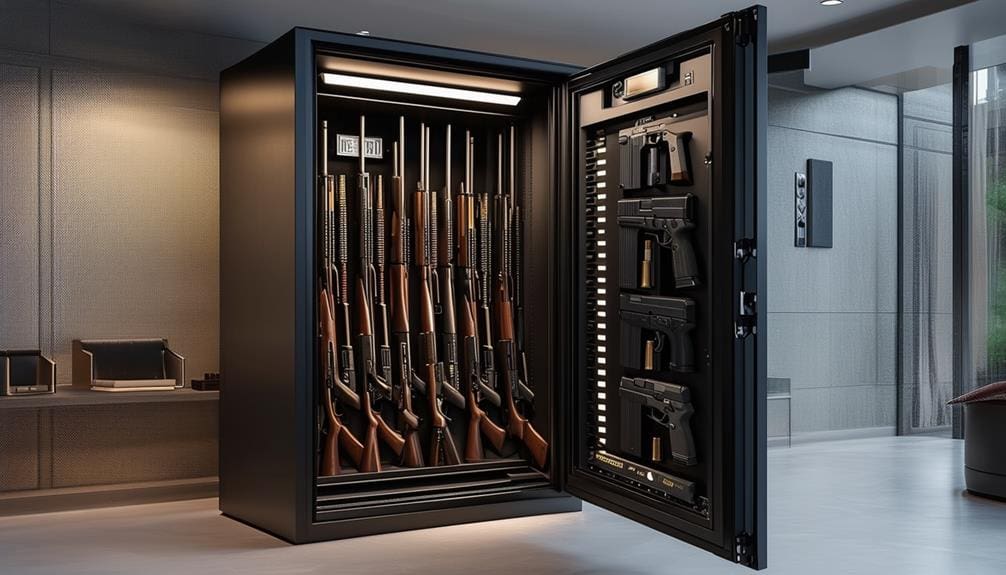
Ensuring the safety of your firearms, gun safes provide a strong solution with various sizes, styles, and advanced locking systems to meet your needs. When selecting a gun safe, consider the metal thickness, as it plays a vital role in protecting your firearms. High-quality gun safes typically use heavier gauge steel and solid plate steel doors to offer enhanced security. This construction deters unauthorized access and helps guarantee your firearms remain secure.
To achieve ideal firearm security, focus on the locking systems of the gun safe. Options include combination locks, electronic keypads, and biometric scanners. Each type has its own advantages, so choose one that aligns with your preferences and security requirements. For instance, biometric scanners offer quick access while maintaining high security, whereas combination locks might provide a more traditional approach.
Fire-Resistant Safes
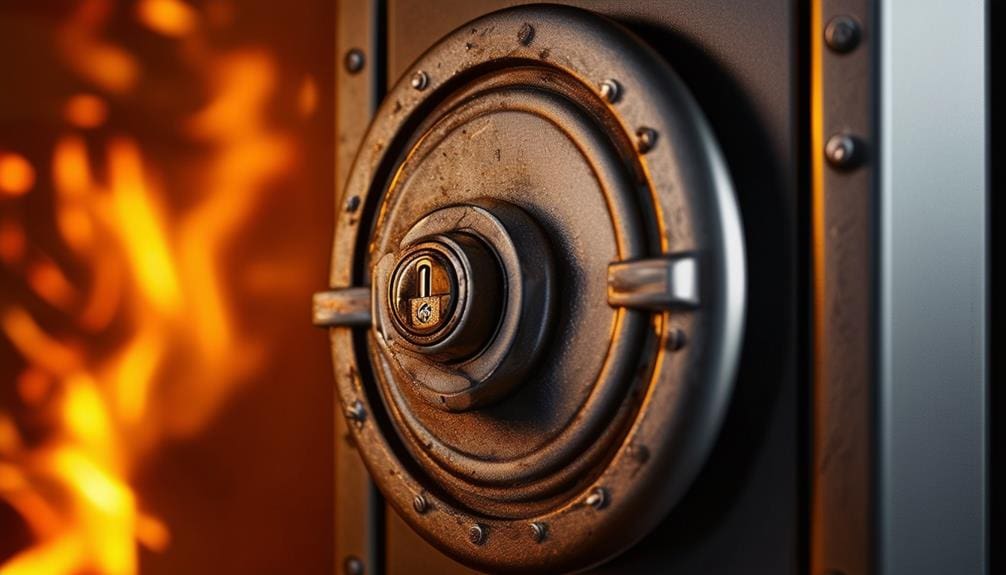
When selecting a fire-resistant safe, you’ll need to weigh the fire protection levels, which indicate how long the safe can withstand high temperatures. Look for safes constructed with materials like fireboard or reinforced steel to guarantee durability. Check the UL certification ratings to verify the safe’s fire resistance and safeguard your valuables remain protected during a fire.
Fire Protection Levels
Fire-resistant safes offer varying levels of protection, typically measured by how long they can withstand high temperatures, such as 30 minutes or 1 hour. These fireproof safes are designed to maintain an internal temperature below specific thresholds, guaranteeing your valuables remain undamaged during a fire. Understanding fire ratings is essential; these ratings indicate the duration and temperature a safe can endure.
To choose a fireproof safe, focus on its UL ratings, which provide a standardized measure of its fire protection capabilities. A UL-rated safe guarantees it has been rigorously tested for resistance to fire. For best protection, select a safe constructed from fire retardant material and with walls thick enough to withstand high temperatures. Aim for a thickness of at least one inch to ensure strong protection.
Fire protection levels vary, so identify what needs safeguarding. Sensitive documents, digital media, and other valuables require different levels of protection. A safe rated for 1-hour fire resistance is ideal for most needs, keeping internal temperature below 350°F to protect paper and other items.
Material and Design
To achieve best fire protection, it’s important to understand the materials and design features that make fire-resistant safes effective. Fire-resistant safes use flame retardant materials and unique structures to withstand high temperatures. Let’s break down the essential components:
- Flame Retardant Materials: These safes often incorporate fireboard, reinforced fireboard, or composite materials. Fireboard is a basic layer that can resist moderate heat, while reinforced fireboard adds extra durability. Composite materials blend various elements for enhanced heat resistance.
- Thickness of Walls and Doors: The thicker the walls and doors, the better the heat resistance. This thickness helps in maintaining lower internal temperatures, protecting your valuables from fire damage. Look for safes with substantial wall and door thickness as a key feature.
- Heat Resistance: Fire-resistant safes come with varying levels of heat resistance. Some are capable of withstanding high temperatures for up to 2 hours. This duration can be critical in ensuring your valuables remain intact during a fire.
UL Certification Ratings
Understanding UL Certification ratings is crucial for selecting a fire-resistant safe that meets your specific protection needs. These ratings, ranging from Class B to Class 150, indicate the safe’s ability to withstand fire damage for a certain duration. UL Certification guarantees that your valuables have a better chance of surviving fires, thanks to specialized construction materials and thick walls designed for varying levels of fire protection.
Here’s a quick guide to the key UL Certification ratings:
| Class Rating | Protection Level |
|---|---|
| Class B | Basic fire protection |
| Class C | Intermediate fire protection |
| Class 150 | High fire protection |
Fire-resistant safes with higher ratings offer enhanced protection levels. For instance, a Class 150 safe can withstand severe fire conditions better than a Class B safe. To choose the right one for your specific needs, consider the value and sensitivity of the items you plan to store. If you’re safeguarding critical documents or irreplaceable heirlooms, opting for a higher-rated safe guarantees better valuables survival.
Data Safes
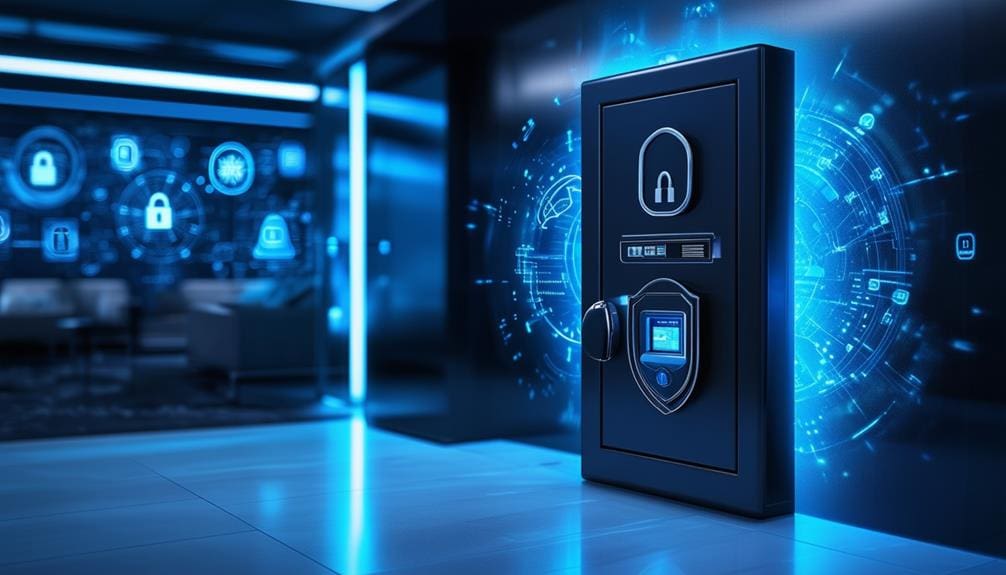
Data safes are vital for protecting electronic media from heat, humidity, and potential damage, guaranteeing your sensitive digital assets remain secure. Whether you’re safeguarding USBs, portable hard drives, or digital files, data safes provide the specialized protection you need. Unlike standard fireproof safes, data safes are designed to maintain internal temperatures below 125 degrees Fahrenheit, offering superior heat protection for your sensitive data.
Here’s how data safes can help you protect your digital assets effectively:
- Fire Protection: Data safes are built to withstand high temperatures, keeping your electronic media safe from fire damage. By maintaining lower internal temperatures, they guarantee that your digital files remain intact even in extreme conditions.
- Humidity Control: These safes also offer humidity protection, preventing moisture from damaging your USBs and portable hard drives. This is essential for maintaining the integrity of your sensitive data over time.
- Physical Security: Data safes are robust and secure, providing a physical barrier against unauthorized access and potential theft of your digital assets.
Depository Safes
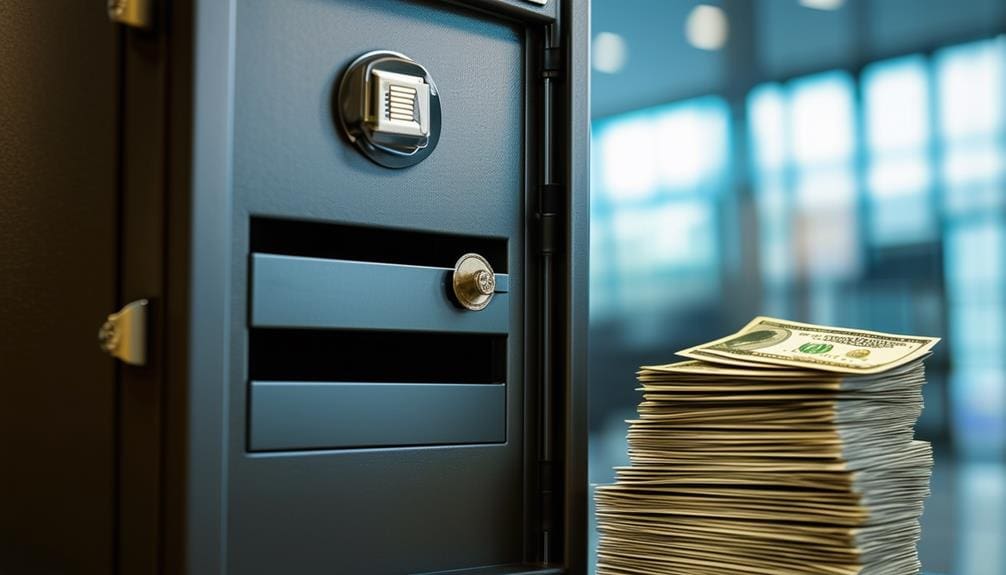
Depository safes, often referred to as drop safes, are essential for businesses needing a secure and effective way to manage cash deposits. These heavy-duty lock boxes provide a reliable solution for cash storage, guaranteeing that financial transactions are handled securely. With built-in slots, depository safes allow for easy and quick deposits without granting access to the main storage compartment. This design notably reduces the risk of unauthorized access, theft, and mishandling.
To use a depository safe, simply place the cash or documents into the slot, where they will drop securely into the main compartment. This feature is particularly useful for businesses that handle frequent cash transactions, such as retail stores and restaurants. By implementing a depository safe, you can streamline your cash management processes and maintain a secure environment for your financial assets.
Depository safes are built to withstand regular use and are constructed from durable materials to offer long-lasting protection. When choosing a depository safe, consider the size and type of lock mechanism that best suits your business needs. By investing in a depository safe, you’re taking a proactive step to safeguard your cash and promote efficient, secure operations.
Hotel Safes
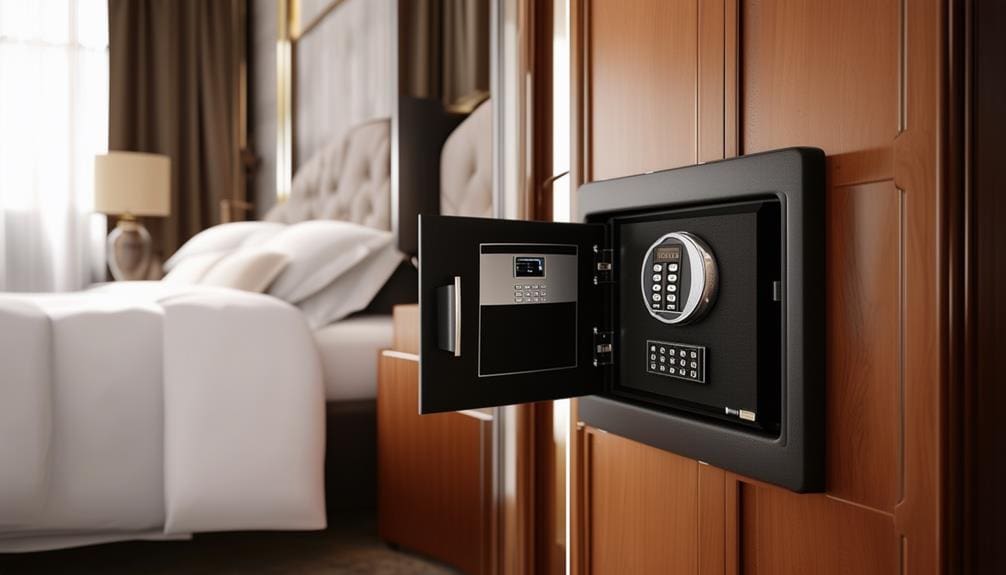
Hotel safes, often found in guest rooms, provide travelers with a convenient and secure place to store their valuables during their stay. These safes are designed to be compact and inexpensive, making them an ideal solution for short-term storage needs. Typically, hotel safes feature a combination lock, which offers an added layer of security for your valuable items.
Here are three key benefits of using hotel safes:
- Security: Hotel safes are built to protect your valuables, such as jewelry and important documents, from theft or unauthorized access. By using a combination lock, you can guarantee that only you have access to your belongings.
- Convenience: As they are compact and located right in your hotel room, hotel safes provide easy access to your valuables whenever you need them. No need to worry about visiting the front desk or a different location for your items.
- Peace of Mind: Knowing that your valuable items are safely stored allows you to enjoy your trip without constantly worrying about their security. This peace of mind is invaluable, especially when traveling in unfamiliar places.
UL Certification
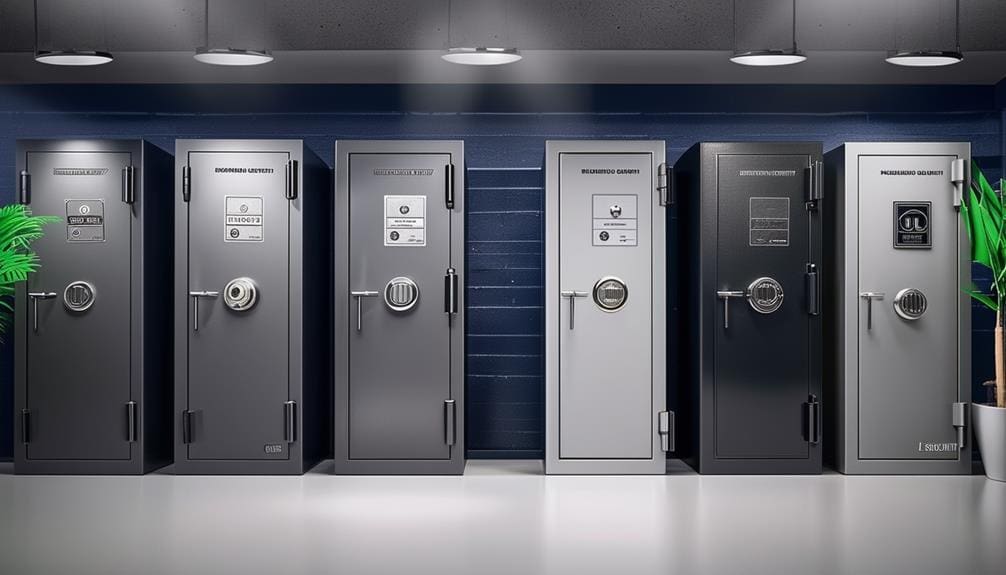
When choosing a safe, understanding UL Certification is crucial for safeguarding your valuables from both theft and fire. UL Certification categorizes safes into various security levels, ranging from Class B to Class 150, each designed to provide specific protection against burglary and fire damage. As a consumer, you’ll want to familiarize yourself with these ratings to select the appropriate safe for your needs.
UL ratings help you gauge the level of security a safe offers. For instance, a Class B safe indicates moderate protection against burglary, whereas a Class 150 safe ensures high resistance to fire damage for up to 2 hours. Understanding these distinctions allows you to make an informed decision based on the type of protection you seek.
To choose the right safe, first assess the kind of valuables you’re storing. For high-value items, a safe with a higher UL rating for both burglary and fire protection is recommended. Always look for examples within the certification to understand what each rating entails. This step-by-step approach guarantees you select a safe that offers the desired level of security and protection, keeping your valuables safe from both theft and fire damage.
Frequently Asked Questions
What Type of Safe Is Best for a Home?
For a home, wall safes offer discreet security, while floor safes provide robust protection. Consider portable safes for flexibility, biometric safes for quick access, and fireproof safes for fire protection. Hidden safes and combination safes add extra security layers.
What Are the 4 Types of Safes?
The four main types of safes are fire safes, mercantile safes, night deposit safes, and gun safes. Wall safes, floor safes, jewelry safes, office safes, portable safes, electronic safes, and combination safes also offer specialized security solutions.
Will Money Burn in a Fireproof Safe?
No, money won’t burn in a fireproof safe. These safes offer cash protection through safe insulation and temperature resistance. Their robust safe construction secures document storage, jewelry security, and electronic locks. Waterproof safes enhance overall protection.
How Do You Keep Valuable Things Safe?
Investigate the truth: to keep valuables safe, use hidden compartments, secure with digital or combination locks, and choose wall or floor safes. For jewelry storage, consider biometric access. Portable safes and key safes offer additional security options.
Conclusion
By understanding the different types of security safes, you’re better equipped to protect your valuables effectively. Each safe serves a unique purpose and offers specific features. Remember, a well-chosen safe isn’t just about storage; it’s about peace of mind. Investigate whether combining multiple safes might offer layered protection, enhancing security. With precise knowledge and careful selection, you’re not just safeguarding items—you’re securing your future. Choose wisely, and your valuables will always be protected.

